
ERCOT staff Feb. 20 said they plan to gain permission from their Board of Directors to use 15 mobile generators as an alternative to relying on two 1960s-era gas units to resolve reliability needs in the San Antonio area.
Nathan Bigbee, ERCOT’s chief regulatory counsel, told the Texas Public Utility Commission that the generators, which are capable of a combined 480 MW of capacity, are more “cost effective” than extending reliability-must-run contracts with Braunig Units 1 and 2, owned by San Antonio’s municipal utility, CPS Energy. The aging units together have a maximum summer rating of 392 MW.
“Our calculation suggests there’s a 15% greater cost-benefit [ratio for] the [mobile] units over the Braunig units based on the fact that they have a shorter start-up time, a slightly better shift factor, and shorter up and down times. We see those as being a net reliability benefit for the grid,” Bigbee told commissioners.
The generators in question, along with several smaller ones, were leased from LifeCycle Power in 2021 by Houston’s CenterPoint Energy for $800 million. However, the larger units have sat unused, despite outages after Hurricane Beryl that lasted more than a week.
The board is holding a special meeting Feb. 25 to consider the mobile generators’ use and a preliminary exit strategy. (See “Staff Still Looking at Braunig,” ERCOT Board of Directors Briefs: Feb. 3-4, 2025.)
Bigbee said CenterPoint has agreed to make the generators available for ERCOT’s use. The grid operator will not compensate CenterPoint but will cover LifeCycle’s costs to move the generators to San Antonio.
LifeCycle has estimated it will cost $26 million to move the generators, while CPS has projected costs of $27 million to connect them to substations. ERCOT says the cost estimates are subject to change.
The latest estimate from CPS to prepare Braunig Units 1 and 2 for continued operation is $54 million. It projects all-in costs, which include an incentive factor and fuel expenses, will run $60 million.
Bigbee said the generators are a “lower-risk solution” compared to extending RMRs for Units 1 and 2. The units would need to go through an inspection before continuing operations. That could reveal additional repairs that need to be made, he said.
“There’s a lot of cost upside risk there that we would have to deal with and potential outage delay risk that could further exacerbate the reliability issues, and so, we see the LifeCycle option as being a win-win in that respect,” Bigbee said.
The municipality told the grid operator in 2024 that it planned to retire the Braunig units in March 2025. However, ERCOT said the plant’s units were needed to address transmission constraints and congestion in the San Antonio area until several transmission projects can be completed. (See ERCOT Evaluating RMR, MRA Options for CPS Plant.)
ERCOT has extended an RMR contract through 2027 to CPS for Braunig Unit 3, which has a 412-MW summer rating.
The grid operator also is working with CPS, AEP Texas and South Texas Electric Cooperative on accelerating the transmission projects south of San Antonio intended to resolve the region’s congestion issues. A rebuild of a second 345-kV circuit is scheduled to be completed in May 2029, but Bigbee said preliminary discussions have indicated the work could be pushed up to January 2027.
“That could resolve some significant reliability issues in the future,” he said. “The earlier we can get those lines in service, the better we believe that the cost-benefit analysis will show that that’s easily a cost-beneficial move.”


